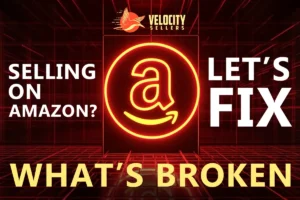Amazon FBA vs. FBM Strategies
Navigating the choice between Fulfilled by Amazon (FBA) and Fulfilled by Merchant (FBM) is like solving a complex puzzle in the labyrinthine world of managing Amazon inventory. Each approach has its own operational and strategic implications. These directly impact a seller’s success in the competitive e-commerce landscape.
Let’s strip down these two methods to their bare-bones basics.
In the case of FBM, sellers maintain complete control over their inventory. This means having warehouse facilities, managing stock levels, and overseeing the entire fulfillment process, from picking and packing to shipping. Additionally, sellers are responsible for handling customer inquiries and returns directly, essentially owning their sales channel through Amazon while maintaining autonomy over the entire process.
Conversely, FBA entails relinquishing some control to Amazon. Sellers send their products in bulk to Amazon’s vast fulfillment centers, where they are stored until sold. Amazon then takes charge of the pick, pack, and ship process, handling customer service inquiries and returns. Essentially, FBA grants sellers access to Amazon’s renowned Prime badge and the allure of expedited shipping, providing a significant competitive edge in the marketplace.
Which One Is Beneficial?
Primarily, FBA grants sellers the coveted Prime badge, a symbol of reliability and expedited shipping that boosts sales. With FBA, sellers tap into Amazon’s efficient fulfillment infrastructure. They offer customers the allure of two-day shipping, a hallmark of the e-commerce giant. This enhances the customer experience and increases the likelihood of winning the Buy Box. The Buy Box is a vital battleground for Amazon sellers struggling for visibility and sales.
Furthermore, FBA streamlines the logistics of managing Amazon’s inventory. It frees sellers from the burdensome tasks of warehousing, picking, packing, and shipping. This saves time and resources, allowing sellers to focus on other aspects of their business. These include product development and marketing.
However, the decision between FBA and FBM isn’t solely dictated by the allure of Prime badges and expedited shipping. Each approach comes with its own set of considerations tailored to individual sellers’ unique needs and circumstances.
For instance, FBM might appeal to sellers with established warehouse facilities and robust fulfillment networks, seeking to maintain complete control over their operations. Conversely, FBA might be the preferred choice for sellers looking to scale rapidly, leveraging Amazon’s vast infrastructure and customer trust to expand their reach and drive sales.
Moreover, the decision between FBA and FBM isn’t set in stone. Sellers have the flexibility to switch between the two models based on evolving business needs and market dynamics. For instance, new products might undergo initial testing through FBM before transitioning to FBA once their viability and demand are established.
Ultimately, whether opting for FBA or FBM, sellers must conduct a thorough cost-benefit analysis, weighing factors such as fulfillment costs, storage fees, and customer service implications. By aligning their choice with their overarching business goals and operational capabilities, sellers can maximize their profitability and efficiency while managing Amazon’s inventory.
FBA vs. FBM Costs
In the realm of managing Amazon inventory, one critical aspect often overlooked is conducting a thorough cost analysis when choosing between Fulfilled by Amazon (FBA) and Fulfilled by Merchant (FBM).
Firstly, regardless of the fulfillment method, sellers must contend with Amazon’s referral fees, typically ranging from 8% to 15% of the sale price, depending on the category. This fee is non-negotiable and directly impacts profitability.
FBA Costs
Moving on to FBA, sellers must factor in additional costs, including fulfillment fees and storage fees charged by Amazon for housing and managing Amazon inventory in their warehouses. These fees vary based on factors such as product size, weight, and storage duration. Additionally, advertising costs should be considered, as promoting products on Amazon’s platform requires financial investment, typically around 10% to 15% of sales revenue.
FBM Costs
On the other hand, FBM entails costs such as warehousing expenses, including rent, utilities, and labor for managing inventory. Sellers may also incur fees for packaging materials and shipping, especially if fulfillment is outsourced to third-party logistics providers (3PLs). These costs can vary significantly depending on factors like order volume, shipping distance, and packaging requirements.
However, it’s crucial to note that customer experience plays a pivotal role in the cost analysis. While FBA offers the allure of Amazon’s renowned customer service and Prime benefits, FBM sellers have different responsibilities. They must provide excellent customer support, which includes promptly addressing inquiries and handling returns. They also ensure timely delivery, an aspect that can significantly impact customer satisfaction and repeat business.
Ultimately, conducting a comprehensive cost analysis involves meticulously calculating all expenses. These include referral fees, fulfillment costs, advertising expenditures, and customer service overheads. By comparing the total costs and weighing them against factors like customer experience, shipping efficiency, and scalability, sellers can make informed decisions. These decisions maximize profitability and align with their business objectives.
Managing Amazon Inventory: A Journey of Optimization
In the world of online retail, where every click can make or break a sale, managing Amazon inventory is like a thrilling adventure. Amidst the hustle and bustle of fulfilling orders from Shopify, WooCommerce, and Amazon itself, a formidable challenge emerged. The challenge is maintaining inventory accuracy while juggling diverse sales channels. This challenge sparked a quest for efficiency and optimization that would redefine the approach to managing Amazon inventory.
Delving deeper into the intricacies of managing Amazon inventory workflows, a trove of tools and techniques was pulled out. From basic spreadsheets to advanced inventory software, various tools were tested to handle inventory effectively.
Yet, amidst this exploration, a common thread emerged: the importance of synchronization. It was realized that a unified approach, with a single source of truth for inventory data, was paramount to maintaining accuracy and efficiency across all channels.
Armed with this insight, sellers embarked on a journey of optimization. They embraced automation, leveraging APIs to seamlessly integrate sales channels and synchronize inventory data in real-time. With structured inventory management practices in place, they met the challenges of managing Amazon’s inventory head-on, ready to emerge victorious in the competitive landscape of e-commerce.
Streamlining Amazon Inventory Management
Once you’ve navigated through the complexities of logistics, the next step is diving into the specifics of managing Amazon inventory, particularly when it comes to sending shipments to Amazon FBA. This process involves careful consideration of what’s required for each product, including labeling and packaging.
Fortunately, Amazon has streamlined the workflow over the years, making it more user-friendly. Sellers can easily set up templates for shipping cartons and quantities, simplifying the process of sending inventory. When it comes to labeling, sellers have options. They can use existing UPC or manufacturing barcodes or opt for Amazon’s Fulfillment Network SKU for added control over their products. Additionally, sellers can choose between shipping methods, whether it’s sending in a pallet or using UPS for smaller shipments. Amazon also offers convenient solutions for managing LTL shipments, including connecting sellers with competitive carriers and automating pickup scheduling.
Overall, understanding the ins and outs of managing Amazon inventory and sending shipments to Amazon FBA is crucial for optimizing efficiency and minimizing complications in the fulfillment process.
How Does Each Fulfillment Method Affect The Buy Box?
Navigating FBA logistics and the intricacies of the Buy Box is essential for successfully managing Amazon inventory. When sellers decide to utilize FBA, they embark on a journey. This journey involves understanding the requirements for sending in shipments, such as carton sizes and labeling specifications. While Amazon has streamlined the process over the years, sellers must ensure they comply with all guidelines. This helps avoid problems during the receiving process. From paperwork to shipping labels, every detail matters to ensure smooth operations.
Moreover, sellers must grasp how each fulfillment method impacts their chances of winning the Buy Box. FBA typically trumps FBM and Seller Fulfilled Prime (SFP) when prices differ. Seller Fulfilled Prime may offer competitive shipping times, but it rarely beats FBA in Buy Box eligibility. Understanding these dynamics is crucial for sellers, especially in competitive niches where securing the Buy Box can make or break sales.
Additionally, sellers must consider long-term storage fees and pricing agreements with wholesalers when deciding between FBA and FBM. If wholesalers undercut prices on other platforms, sellers risk losing the Buy Box on Amazon, potentially leading to long-term storage fees if inventory doesn’t move quickly. Therefore, sellers must weigh these factors carefully when determining the most suitable fulfillment method for managing Amazon inventory.
Navigating Seller Fulfilled Prime While Managing Amazon Inventory
Navigating the complexities of Seller Fulfilled Prime (SFP) raises questions about its benefits and challenges. While achieving the Prime badge and fulfilling orders from one’s warehouse may seem appealing, it comes with strict requirements to maintain Prime status. Meeting criteria such as on-time delivery rates and low cancellation percentages is essential to retain the badge.
However, the stress of matching Amazon’s service standards, especially regarding Saturday shipping and employee management, can outweigh the perceived benefits. Despite its potential advantages for certain niche businesses with slow-moving products or storage limitations, many sellers find the demands and risks of SFP outweigh the rewards. Ultimately, the decision to pursue Seller Fulfilled Prime requires careful consideration of its implications and suitability for individual business needs.
Navigating FBA vs. FBM: A Strategic Approach to Amazon Fulfillment
As we wrap up our discussion, it’s clear that the choice between Fulfillment by Amazon (FBA) and Fulfillment by Merchant (FBM) ultimately comes down to profitability and logistics while managing Amazon inventory.
Sellers must weigh the pros and cons of each method based on their specific products, volume, and business goals. Regardless of the chosen approach, staying informed about evolving policies and fees is essential for navigating the ever-changing landscape of selling on Amazon. Stay tuned for more in-depth discussions on managing Amazon inventory, navigating the complexities of e-commerce, and maximizing success on the Amazon platform.
Learn how to manage third-party sellers and maintain your brand on Amazon in our detailed guide. Read more at Brand Alignment: Your Unwanted 3P Sellers on Amazon.









